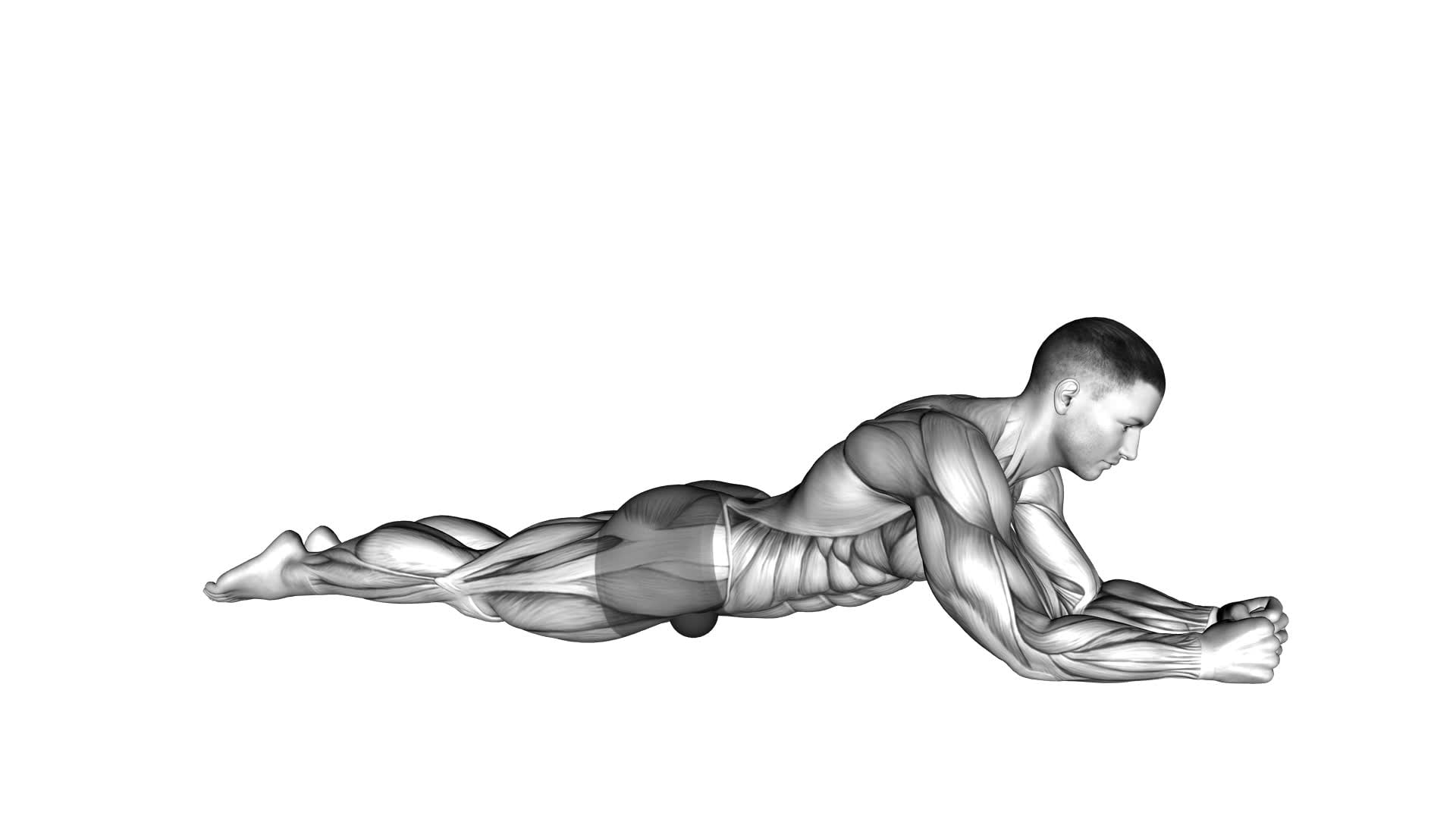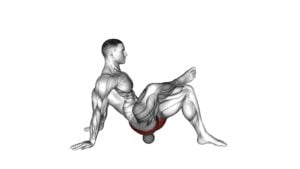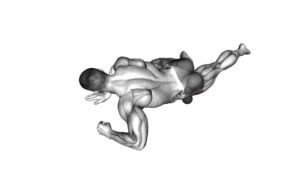Roll Ball Iliospsoas – Video Exercise Guide & Tips

Looking to strengthen your iliopsoas muscles? Look no further than the roll ball iliopsoas exercise!
Watch This Exercise Video
In this video exercise guide, we'll show you the proper technique, equipment setup, and common mistakes to avoid.
Plus, we'll give you tips for increasing intensity and progression. Whether you're a beginner or advanced, this exercise will help you improve your core stability and overall body strength.
So grab a ball and let's get started!
Key Takeaways
- Roll Ball Iliopsoas exercise strengthens hip flexors and improves lower body stability.
- It enhances flexibility and range of motion in the hip flexors.
- The exercise engages and strengthens core muscles.
- It is a valuable addition to any workout routine, suitable for athletes, dancers, and individuals looking to improve flexibility.
Benefits of the Roll Ball Iliospsoas Exercise
The Roll Ball Iliospsoas exercise offers numerous benefits for strengthening your hip flexors and improving overall lower body stability. This exercise is highly effective in improving flexibility and enhancing the strength of your core muscles. By engaging the iliopsoas muscle, which is responsible for flexing the hip joint, you can target and strengthen this important muscle group.
One of the key benefits of the Roll Ball Iliospsoas exercise is its ability to improve flexibility. As you roll the ball forward and backward, you're actively stretching and lengthening the hip flexors. This increased range of motion can be beneficial for athletes, dancers, and individuals looking to improve their overall flexibility.
Additionally, this exercise helps to strengthen your core. As you stabilize your body on the ball, your abdominal muscles are engaged to maintain balance. This not only improves your core strength but also helps to improve your overall stability and posture.
Incorporating the Roll Ball Iliospsoas exercise into your workout routine can be a great way to target and strengthen your hip flexors while also improving flexibility and core stability. Whether you're an athlete or simply looking to improve your overall fitness, this exercise can be a valuable addition to your routine.
Proper Equipment and Setup
To ensure a successful Roll Ball Iliospsoas exercise, it's essential to have the proper equipment and set it up correctly.
The first point to consider is the essential equipment needed for the exercise. This includes a stability ball and a flat, non-slip surface.
Once you have the necessary equipment, it's important to follow the correct setup technique to ensure safety and effectiveness during the exercise.
Essential Equipment for Setup
Using proper equipment and setup is crucial for performing the roll ball iliopsoas exercise effectively. To set up for this exercise, you'll need a stability ball and a wall.
It's important to choose a stability ball that's the right size for your height. Recommended brands include Gaiam, Bosu, and TheraBand. These brands offer high-quality stability balls that are durable and provide the necessary support for the exercise.
When selecting a stability ball, make sure it's inflated to the proper level to maintain stability during the exercise. Additionally, find a wall that's clear of any obstacles and provides enough space for you to move freely.
Correct Setup Technique
To set up correctly for the roll ball iliopsoas exercise, ensure you have the right equipment and proper setup techniques. The most common error during setup isn't positioning the roll ball correctly. Make sure the ball is placed under your lower abdomen, just above your hip bone. This will target the iliopsoas muscles effectively.
Another common mistake is using a ball that's too large or too small. The ideal size is one that allows your knees to be bent at a 90-degree angle when you're in the starting position.
As for advanced variations, you can increase the difficulty by adding resistance bands around your ankles or holding dumbbells in your hands.
Now that you know the importance of correct setup technique, let's move on to the step-by-step guide for the correct technique.
Step-by-Step Guide for Correct Technique
Start by placing a small exercise ball between your knees. This step-by-step guide will help you perform the Roll Ball Iliospsoas exercise with correct technique. Follow these instructions to ensure you get the most out of this exercise:
- Lie on your back with your knees bent and feet flat on the floor.
- Squeeze the exercise ball between your knees, engaging your inner thigh muscles.
- Place your arms by your sides, palms facing down.
- Slowly lift your hips off the ground, pressing through your heels and keeping your core engaged.
By following these steps, you can avoid common technique errors and ensure you're performing the exercise correctly. Remember to start with lighter variations if you're a beginner. As you become more comfortable, you can increase the intensity by using a larger exercise ball or adding resistance bands.
Now that you know the correct technique, let's move on to the next section where we'll discuss common mistakes to avoid.
Common Mistakes to Avoid
To avoid common mistakes, make sure you keep the following points in mind while performing the Roll Ball Iliospsoas exercise.
Proper technique is crucial to maximize the effectiveness of this exercise and prevent injury. One common mistake is using momentum instead of controlled movements. Remember to engage your core and control the movement as you roll the ball back and forth. Rushing through the exercise can lead to poor form and reduce the benefits of the exercise.
Another mistake to avoid is neglecting proper alignment. Ensure that your body is properly aligned throughout the exercise. Keep your spine neutral and your shoulders relaxed. Avoid arching your back or hunching your shoulders, as this can strain your muscles and lead to discomfort or injury.
It is also important to avoid using excessive force or straining your muscles. Start with a lighter resistance ball and gradually increase the intensity as your strength improves. Pushing yourself too hard can lead to muscle strains or other injuries.
Lastly, pay attention to your breathing. Many people tend to hold their breath during exercises, which can lead to tension and improper form. Remember to breathe deeply and exhale as you engage your muscles.
Tips for Increasing Intensity and Progression
To increase the intensity and progression of the Roll Ball Iliospsoas exercise, gradually incorporate heavier resistance balls as your strength improves. Here are some tips for increasing difficulty and advanced modifications:
- Use a larger resistance ball: Start with a smaller ball and gradually work your way up to a larger one. This will increase the challenge on your iliopsoas muscles and help build strength.
- Elevate your feet: Place your feet on an elevated surface, such as a bench or step, while performing the exercise. This will increase the range of motion and further engage your iliopsoas muscles.
- Add external resistance: Hold a weight plate or dumbbell against your chest while performing the exercise. This will add extra resistance and make the exercise more challenging.
- Incorporate single-leg variations: Lift one leg off the ground while performing the exercise. This will increase the demand on your iliopsoas muscles and improve stability.
By gradually incorporating these advanced modifications, you can continue to challenge your muscles and make progress in your Roll Ball Iliospsoas exercise routine.
Now, let's move on to the next section, where we'll discuss important safety precautions and modifications to keep in mind.
Safety Precautions and Modifications
Before you start performing the Roll Ball Iliospsoas exercise, it's important to take safety precautions to prevent injuries.
- Make sure you have a stable and non-slip surface to perform the exercise on.
- Additionally, it's crucial to listen to your body and modify the exercise if needed, especially if you have any pre-existing conditions or limitations.
Injury Prevention Techniques
During your workouts, always prioritize your safety by implementing injury prevention techniques. This will help you avoid potential injuries and ensure a successful and enjoyable exercise session.
Here are four important injury prevention techniques to incorporate into your routine:
- Warm up exercises: Begin your workout with a dynamic warm up to increase circulation, raise your body temperature, and prepare your muscles for the upcoming activity. This can include light cardio exercises like jogging or jumping jacks.
- Stretching techniques: After a proper warm up, perform static stretches to improve flexibility and range of motion. Focus on the major muscle groups you'll be using during your workout, holding each stretch for 15-30 seconds without bouncing.
- Proper form and technique: Always prioritize proper form and technique during exercises to minimize the risk of injury. This includes maintaining good posture, engaging your core, and using the correct range of motion.
- Gradual progression: Avoid overexertion and allow your body to adapt by gradually increasing the intensity, duration, or weight of your workouts. This will help prevent overuse injuries and give your body time to recover and rebuild.
Adaptations for Different Abilities
Make adaptations to the roll ball iliopsoas exercise to accommodate different abilities and ensure safety. It's important to provide modifications for disabilities and create inclusive exercise options.
For individuals with limited mobility or strength, you can start by using a smaller ball or a softer surface to reduce the difficulty level. If someone is unable to perform the exercise while lying on their stomach, they can try doing it while lying on their side or sitting on a chair.
Additionally, you can provide additional support, such as using a stability ball or having a partner assist with stabilizing the body.
Frequently Asked Questions
Can the Roll Ball Iliospsoas Exercise Help With Lower Back Pain?
Yes, incorporating the roll ball iliospsoas exercise into your daily workout routine can help with lower back pain.
This exercise specifically targets the iliospsoas muscle, which connects the lower back to the hip. Strengthening this muscle can improve stability and support for the lower back, reducing pain and discomfort.
To perform the exercise properly for maximum effectiveness, lie face down on a mat with a small exercise ball under your hip. Roll the ball back and forth using your hips, keeping your core engaged.
How Often Should I Perform the Roll Ball Iliospsoas Exercise to See Results?
To see results from the roll ball iliospsoas exercise, it's important to perform it regularly. Consistency is key. You should aim to do this exercise at least three times a week. By doing so, you can start experiencing the benefits in as little as a few weeks.
The roll ball iliospsoas exercise helps strengthen and stretch the muscles in your lower back and hips, which can alleviate lower back pain and improve your overall flexibility and mobility.
What Are Some Alternative Exercises That Target the Same Muscle Group as the Roll Ball Iliospsoas Exercise?
If you're looking for alternative exercises that target the same muscle group as the roll ball iliospsoas exercise, there are a few options you can try.
Some effective alternatives include leg raises, lunges, and bicycle crunches.
These exercises not only work the iliospsoas muscles, but also provide a range of benefits such as improved core strength, stability, and flexibility.
Incorporating these alternative exercises into your routine can help you achieve your fitness goals and keep your workouts varied and engaging.
Can the Roll Ball Iliospsoas Exercise Be Modified for Individuals With Limited Mobility?
If you have limited mobility, you may be wondering if the roll ball iliospsoas exercise can be modified for you. The good news is that yes, this exercise can be modified to suit your needs.
By making some modifications, such as using a smaller ball or performing the exercise in a seated position, you can still reap the benefits of targeting your iliospsoas muscle group.
These modifications can help you improve your mobility and strength, even with limited range of motion.
Is It Necessary to Warm up Before Performing the Roll Ball Iliospsoas Exercise?
Before performing the roll ball iliospsoas exercise, it's essential for you to warm up. Warming up has several benefits, including increasing blood flow to your muscles, improving joint mobility, and preparing your body for the upcoming exercise.
It's also important to stretch your muscles before starting the exercise to prevent injury and enhance your range of motion. So, take a few minutes to warm up and stretch before diving into the roll ball iliospsoas exercise.
Conclusion
In conclusion, the roll ball iliospsoas exercise is a beneficial way to strengthen and stretch the hip flexor muscles. By using the proper equipment and following the correct technique, you can effectively target this muscle group.
It's important to avoid common mistakes and gradually increase intensity for progression. Remember to prioritize safety and make any necessary modifications to suit your individual needs.
Incorporating this exercise into your routine can help improve hip mobility and overall lower body strength.

Author
Years ago, the spark of my life’s passion ignited in my mind the moment I stepped into the local gym for the first time. The inaugural bead of perspiration, the initial endeavor, the very first surge of endorphins, and a sense of pride that washed over me post-workout marked the beginning of my deep-seated interest in strength sports, fitness, and sports nutrition. This very curiosity blossomed rapidly into a profound fascination, propelling me to earn a Master’s degree in Physical Education from the Academy of Physical Education in Krakow, followed by a Sports Manager diploma from the Jagiellonian University. My journey of growth led me to gain more specialized qualifications, such as being a certified personal trainer with a focus on sports dietetics, a lifeguard, and an instructor for wellness and corrective gymnastics. Theoretical knowledge paired seamlessly with practical experience, reinforcing my belief that the transformation of individuals under my guidance was also a reflection of my personal growth. This belief holds true even today. Each day, I strive to push the boundaries and explore new realms. These realms gently elevate me to greater heights. The unique combination of passion for my field and the continuous quest for growth fuels my drive to break new ground.







